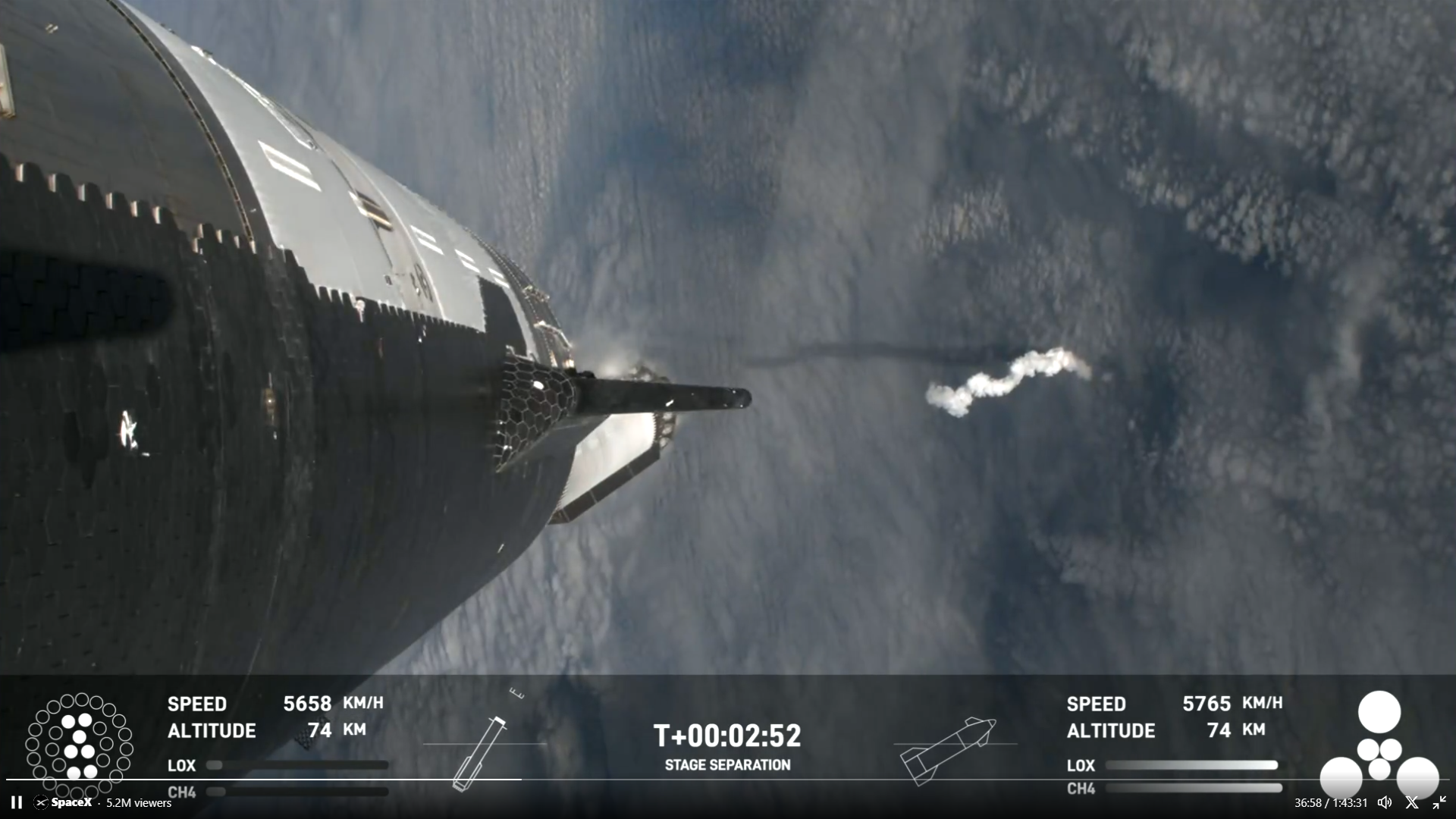
SpaceX has successfully launched its third Integrated Flight Test (IFT-3) of a fully stacked Starship/Super Heavy combo out of Starbase in Boca Chica, Texas. Following more than an hour of delay, due to high winds at the launch site and the need to shoo away shrimping boats from the keep-out zone in the Gulf of Mexico, the 394-foot-tall (120-meter) behemoth took flight at 8:25 a.m. CDT and executed a number of critical milestones: full-duration Raptor engine “burns” of both vehicles, satisfactory “hot-staging” and “boost-back” burns, in-space propellant transfer and a good opening and closure of Starship’s payload bay (or “pez”) door. However, both vehicles were apparently lost during the final stages of today’s mission.


As its name suggests, IFT-3 is the third fully integrated mission by a Starship/Super Heavy stack, following two earlier launches last 20 April and 18 November. Powering aloft under 16.7 million pounds (7.5 million kilograms) of thrust from its 33 Raptor engines, the vehicle is currently the most powerful orbital-class rocket.


Last April’s IFT-1 mission saw the stack establish a new record for the greatest liftoff impulse of any booster in history, greatly surpassing the 7.5 million pounds (3.4 million kilograms) of the long-retired Saturn V, the 8.8 million pounds (3.9 million kilograms) of the Space Launch System (SLS) on November 2022’s Artemis I mission and even the Soviet Union’s N-1 rocket, which reportedly produced 10.2 million pounds (4.6 million kilograms) during its four failed launch attempts between February 1969 and November 1972.


However, although IFT-1 cleared the Boca Chica launch pad and attained altitude, it suffered a multitude of technical maladies which ultimately conspired to an untimely—though visually spectacular—demise. Last November’s IFT-2 saw all 33 Raptors burn successfully through Main Engine Cutoff (MECO), followed by a satisfactory “hot-staging” exercise as the 233-foot-long (71-meter) Super Heavy was discarded and executed a flip maneuver and an (almost) wholly nominal burn profile of the six Raptors aboard the 164-foot-long (50-meter) Starship itself.


But as the IFT-2 stack headed out over the Gulf of Mexico, the Autonomous Flight Safety System (AFSS) issued a destruct command to destroy the vehicle. Following a mishap investigation conducted under the auspices of the FAA and completed in late February, SpaceX identified 17 corrective actions—ten to the Starship, seven to the Super Heavy—including the implementation of an all-electric Thrust Vector Control (TVC) system and improving the speed of propellant loading operations before launch.


Preparations for IFT-3 got underway last December, with Raptor static-fire testing of the Super Heavy (tailnumbered “Booster Ten”) and the Starship (designated “Ship 28”). Earlier in March, the fully integrated stack was put through a full day-of-launch dress rehearsal, including loading more than ten million pounds (4.5 million kilograms) of liquid oxygen and liquid methane propellants and a flight-like countdown down to T-10 seconds.


On Tuesday, SpaceX tweeted on X that the stack was erect on the pad and ready to go, pending final regulatory approval from the Federal Aviation Administration (FAA). That approval was forthcoming yesterday and SpaceX announced its intent to pursue a launch during a 110-minute “window”, opening at 7 a.m. CDT Thursday.


As Thursday dawned, weather conditions in this coastal patch of South Texas hovered around 70-percent-favorable, although teams continued to monitor winds as the launch window neared. Hopes of flying at the start of the nearly-two-hour window proved fruitless, thanks to the need to shoo shrimping boats out of the keep-out zone, which pushed T-0 firstly to 8:02 a.m. EDT, then 8:10 a.m. EDT and eventually 8:25 a.m. CDT.


Propellant loading of Booster Ten and Ship 28 got underway shortly after 7:30 a.m. CDT. And in the final few minutes before liftoff the 39 Raptor engines—33 at the base of the Super Heavy and six aboard the Starship—were chilled down ahead of ignition.


Beginning at T-4 seconds, IFT-3’s ignition regime got underway as the Super Heavy Raptors came alive in distinct “banks”: firstly 13 inner engines, then 15 outer engines and finally the last five engines in the last couple of seconds prior to T-0. The stack blazed through peak aerodynamic turbulence (colloquially known as “Max Q”) a minute into the flight and continued to power onwards, until Starship executed a “Hot Stage” maneuver of its six Raptors and all but three of the Super Heavy’s engines shut down crisply and with perfection at two minutes and 40 seconds.


By this stage of the mission, the IFT-3 stack was traveling in excess of 3,540 mph (5,700 km/h). Shortly after separation of the two stages, the Super Heavy briefly re-lit its 13 inner engines as part of a minute-long “boost-back” burn.


Meanwhile, three and a half minutes into flight and by now traveling at over 4,160 mph (6,700 km/h) under the rock-steady push of her Raptors, the Starship crossed the 62-mile-high (100-kilometer) “Kármán Line”, the internationally recognized lowermost limit for the edge of space. The engines shut down precisely on time at 8.5 minutes, after which the giant spacecraft—whose 164-foot (50-meter) length makes it longer than the Space Shuttle and Russia’s flagship Mir space station—coasted for more than a half-hour, during which time it successfully demonstrated an in-space propellant transfer capability and the actuation of its payload bay (or “pez”) doors.


SpaceX confirmed the completion of the propellant transfer demo at 8:52 a.m. CDT and the closure of the pez doors at 8:55 a.m. CDT. However, a planned re-light of the six Raptors at 40 minutes into the mission did not occur and Starship re-entered the atmosphere for a “hard” splashdown but was lost before impacting the waters of the Indian Ocean. Nevertheless, the re-entry which began at T+49 minutes, allowed for an evaluation of Starship’s 18,000 hexagonal Thermal Protection System (TPS) tiles at temperatures in the region of 1,400 degrees Celsius (2,600 degrees Fahrenheit).


“Huge congratulations to the entire team for this incredible day,” tweeted SpaceX President Gwynne Shotwell on X. “Clean count (glad the shrimpers could get out in the nick of time), liftoff, hot staging, Super Heavy boost-back and coast (and likely a couple engines making main-stage during landing burn), clean ship insertion and coast, payload bay door cycling and prop transfer demo (to be confirmed) and ship entry.”







